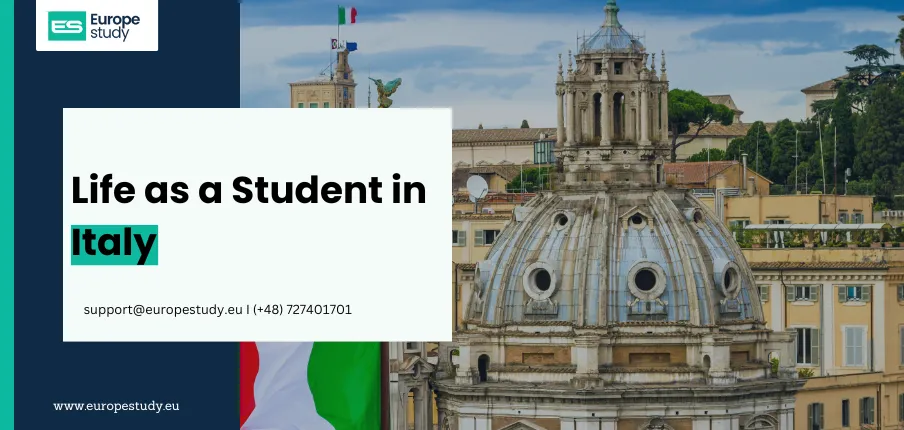
Life as a Student in Italy
Italy is a dream destination for many international students. With its world-renowned universities, rich history, and vibrant culture, studying in Italy offers an experience that goes beyond the classroom. Whether you’re drawn to the art-filled streets of Florence, the bustling metropolitan life of Milan, or the historic charm of Rome, being a student in Italy is a unique and enriching adventure. This guide will give you a detailed look into life as a student in Italy, covering academics, daily life, costs, and more.
1. Education System and Universities
Italy is home to some of the oldest and most prestigious universities in the world, such as the University of Bologna (the oldest university in Europe), Sapienza University of Rome, and Politecnico di Milano. The country offers a range of courses in English and Italian, catering to international students from diverse backgrounds.
Key Highlights:
- Universities follow the Bologna Process, ensuring degrees are recognized across Europe.
- Courses are divided into Bachelor’s (Laurea Triennale), Master’s (Laurea Magistrale), and PhD programs.
- The academic year typically runs from September to June, with two main semesters.
- Exams are often oral, which might be a new experience for some students.
2. Cost of Living and Student Budget
Living costs in Italy vary depending on the city. Milan and Rome are among the most expensive, while smaller cities like Bologna or Padua offer a more affordable lifestyle.
Estimated Monthly Expenses:
- Accommodation: €300 - €700 (depending on shared/private apartment and city)
- Food: €150 - €300
- Transport: €25 - €50 (student passes available)
- Miscellaneous (entertainment, personal expenses): €100 - €200
To manage expenses, many students take advantage of scholarships, part-time jobs, and student discounts.
3. Accommodation Options
Finding housing as a student can be challenging, especially in big cities. Options include:
- University dormitories – Affordable but limited availability.
- Private apartments – More independence but higher costs.
- Shared flats (appartamenti condivisi) – A common choice among students to split rent.
- Homestays – A great way to experience Italian culture firsthand.
Websites like Spotahome, Uniplaces, and HousingAnywhere are popular for finding student accommodations.
4. Student Life and Social Scene
Italian student life is lively and social. Universities often have student organizations and Erasmus networks, organizing events, cultural exchanges, and trips.
- Aperitivo Culture: A popular evening tradition where students gather for drinks and snacks before dinner.
- Festivals and Events: Italy hosts numerous cultural and music festivals, from Carnevale in Venice to film festivals in Rome.
- Sports and Outdoor Activities: Many students enjoy football, cycling, hiking, and skiing in winter.
- Nightlife: Cities like Milan, Florence, and Rome have vibrant nightlife with bars, clubs, and social gatherings.
5. Food and Eating Habits
Italy is a paradise for food lovers, and students can enjoy delicious meals without breaking the bank.
- University mensa (cafeterias) provide cheap meals (€3 - €6).
- Pizzerias, trattorias, and street food stalls offer affordable options like pizza al taglio (pizza by the slice) and panini.
- Cooking at home is common, with fresh ingredients available in local markets.
- Students often gather for communal meals, making dining a social experience.
6. Transportation and Travel
Public transport in Italy is well-developed, making it easy for students to commute.
- Buses, metro, and trams: Available in major cities with student discounts.
- Trains: Italy’s high-speed trains (Frecciarossa, Italo) make traveling between cities convenient.
- Cycling: Many cities, like Bologna and Ferrara, are bike-friendly.
- Weekend Trips: Students often explore nearby European destinations due to Italy’s central location.
7. Work Opportunities for Students
Many students take part-time jobs to support themselves.
- Part-time work (lavoro part-time): Allowed up to 20 hours per week for non-EU students.
- Teaching English or Tutoring: A common job for international students.
- Hospitality and Retail: Jobs in cafes, restaurants, and shops.
- Internships: Many universities have partnerships with companies offering internships.
8. Language and Communication
Although many courses are available in English, learning Italian is highly beneficial.
- Free or low-cost language courses are available at universities.
- Knowing Italian helps with job opportunities, social interactions, and daily life.
- Apps like Duolingo and Tandem can help improve language skills.
9. Challenges and Tips for Adaptation
While studying in Italy is an incredible experience, it comes with challenges.
- Bureaucracy: Dealing with visa renewals, permits, and paperwork can be slow.
- Cultural Differences: Italians have a relaxed attitude toward time, so expect delays.
- Finding Housing: It can be competitive, so start early.
Tips for a Smooth Experience:
- Learn basic Italian phrases to ease communication.
- Join student groups to make friends and integrate faster.
- Explore beyond tourist spots to truly experience Italian culture.
- Stay patient when dealing with administrative processes.
Conclusion
Being a student in Italy is an unforgettable experience filled with learning, adventure, and cultural immersion. Whether you’re enjoying an espresso in a historic piazza, traveling through scenic landscapes, or making lifelong friends, your time in Italy will be an enriching chapter in your academic and personal growth. If you’re considering studying in Italy, embrace the journey—it will be one of the best decisions you ever make!





